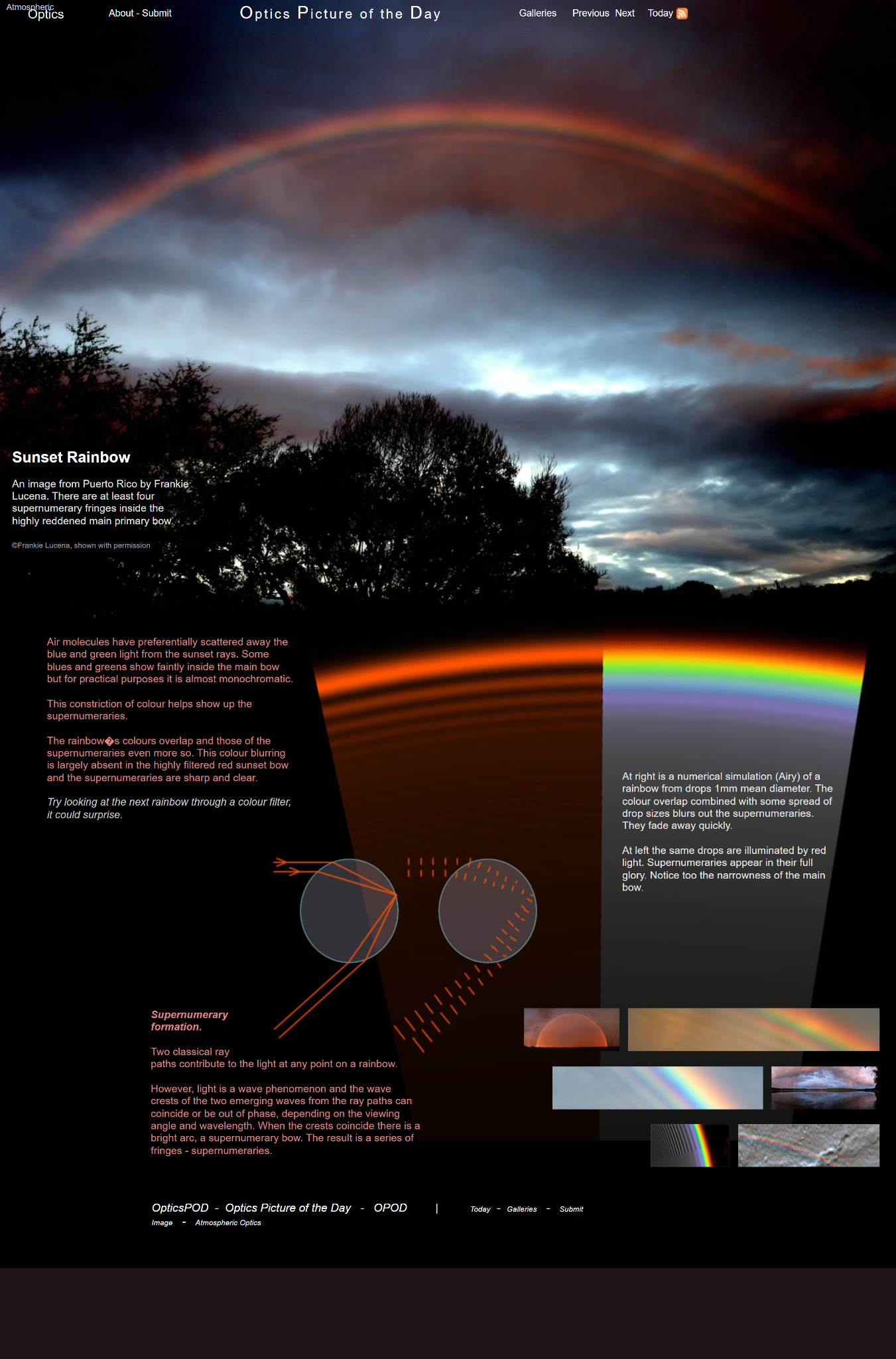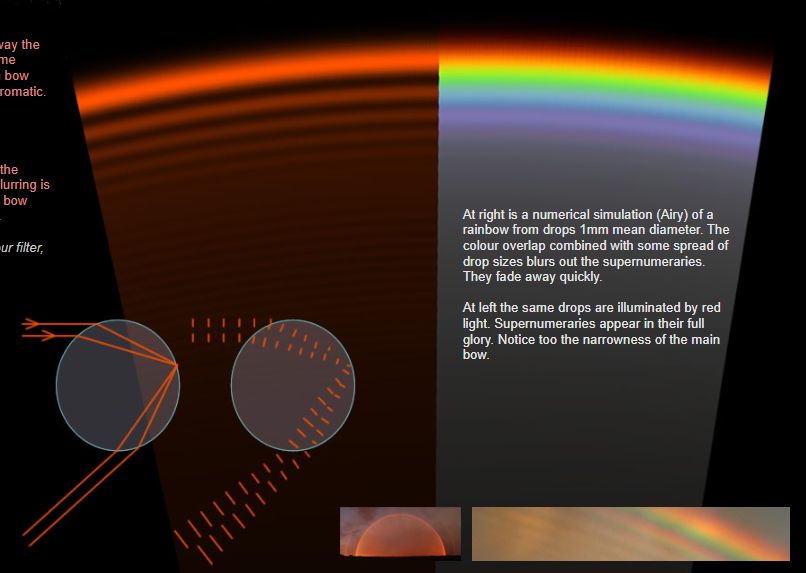Sunset Bow - OPOD
Sunset Bow: A Spectacular Atmospheric Optics Phenomenon
Have you ever witnessed a sunset rainbow? This captivating atmospheric optics phenomenon occurs when the setting sun's rays interact with water droplets in the atmosphere, creating a stunning display of colors in the sky. In this blog post, we will delve deeper into the intricacies of the sunset bow, exploring its formation, characteristics, and the role of light in shaping its appearance.
The Beauty of the Sunset Bow
One remarkable example of a sunset bow was captured in an image taken by Frankie Lucena in Puerto Rico. In this photograph, we can observe not only the prominent primary bow but also the presence of four supernumerary fringes within it. These additional fringes appear as delicate bands of colors inside the main bow, adding a touch of ethereal beauty to the scene.
The Influence of Light and Color
To understand the sunset bow phenomenon, it is crucial to consider the behavior of light as it interacts with water droplets in the atmosphere. A numerical simulation, known as Airy, provides insight into this process. When drops with a mean diameter of 1mm are illuminated by white light, the resulting rainbow exhibits a blend of colors due to the overlap of different wavelengths. This color overlap, combined with variations in drop sizes, causes the supernumeraries to blur and fade away quickly.
However, when drops of the same size are illuminated solely by red light, a remarkable transformation occurs. The supernumeraries regain their full glory, appearing sharp and distinct. Furthermore, the main bow becomes noticeably narrower. This narrowing effect is a result of blue and green light being preferentially scattered away by air molecules, leaving behind a nearly monochromatic display dominated by red hues. The reduced range of colors in the sunset bow enhances the visibility of the supernumeraries.
Exploring Supernumerary Formation
Supernumeraries are an integral part of the sunset bow phenomenon. To understand their formation, we must consider the wave nature of light. As light waves emerge from two distinct ray paths within a water droplet, their wave crests can either coincide or be out of phase, depending on the viewing angle and wavelength. When the wave crests coincide, a bright arc, known as a supernumerary bow, is formed. These arcs create a series of fringes, which we perceive as the supernumeraries within the main bow.
Observing Sunset Bows Through Filters
If you ever have the opportunity to observe a rainbow, whether it be during a sunset or under different lighting conditions, consider looking at it through a color filter. Filtering the light can yield surprising results, altering the appearance and intensity of the colors within the bow. This experiment allows us to appreciate the profound impact that light and its interaction with water droplets have on the formation and perception of atmospheric optics phenomena.
In conclusion, the sunset bow is a captivating atmospheric optics phenomenon that unveils its full splendor during sunset hours. Its formation and characteristics are intricately linked to the behavior of light and the properties of water droplets in the atmosphere. By understanding the science behind this phenomenon, we can deepen our appreciation for the wonders of nature and the awe-inspiring displays it presents to us. So, next time you witness a sunset rainbow, take a moment to marvel at its beauty and contemplate the intricate interplay between light and water droplets that gives rise to this extraordinary spectacle.

Sunset Rainbow
An image from Puerto Rico by Frankie Lucena. There are at least four supernumerary fringes inside the highly reddened main primary bow.
©Frankie Lucena, shown with permission

At right is a numerical simulation (Airy) of a rainbow from drops 1mm mean diameter. The colour overlap combined with some spread of drop sizes blurs out the supernumeraries. They fade away quickly.
At left the same drops are illuminated by red light. Supernumeraries appear in their full glory. Notice too the narrowness of the main bow.
Air molecules have preferentially scattered away the blue and green light from the sunset rays. Some blues and greens show faintly inside the main bow but for practical purposes it is almost monochromatic.
This constriction of colour helps show up the supernumeraries.
The rainbow�s colours overlap and those of the supernumeraries even more so. This colour blurring is largely absent in the highly filtered red sunset bow and the supernumeraries are sharp and clear.
Try looking at the next rainbow through a colour filter, it could surprise.
Supernumerary formation.
Two classical ray paths contribute to the light at any point on a rainbow.
However, light is a wave phenomenon and the wave crests of the two emerging waves from the ray paths can coincide or be out of phase, depending on the viewing angle and wavelength. When the crests coincide there is a bright arc, a supernumerary bow. The result is a series of fringes - supernumeraries.
Note: this article has been automatically converted from the old site and may not appear as intended. You can find the original article here.
Reference Atmospheric Optics
If you use any of the definitions, information, or data presented on Atmospheric Optics, please copy the link or reference below to properly credit us as the reference source. Thank you!
-
<a href="https://atoptics.co.uk/blog/sunset-bow-opod/">Sunset Bow - OPOD</a>
-
"Sunset Bow - OPOD". Atmospheric Optics. Accessed on April 19, 2024. https://atoptics.co.uk/blog/sunset-bow-opod/.
-
"Sunset Bow - OPOD". Atmospheric Optics, https://atoptics.co.uk/blog/sunset-bow-opod/. Accessed 19 April, 2024
-
Sunset Bow - OPOD. Atmospheric Optics. Retrieved from https://atoptics.co.uk/blog/sunset-bow-opod/.